Table Of Contents
It’s no secret:
Selling to B2B customers is hard.
At times, it can feel almost impossible.
Of course, selling was never easy.
But, the days when a salesperson was in charge of the buying process are long gone.
Today’s buyers prefer to conduct research and select what to buy on their own, without any influence from a vendor:
- Only 29% of buyers want to talk to a salesperson to learn more about a product,
- 57% of buyer decisions are made before buyers even pick up a phone to speak to a supplier,
- And, 34% of salespeople admit that closing deals is getting harder.
Surprisingly, only 17% of the entire B2B buying process is spent meeting with potential suppliers.
But, does this mean that the days of reaching your sales quotas are gone?
No, of course not!
However, to keep closing new deals, you first need to understand the dynamics of modern B2B sales. Then, you need learn the sales strategies that will help you achieve it.
And that’s exactly what we’re going to share with you today.
In this article, we’ll discuss the meaning of B2B sales, how to sell to modern B2B buyers and, share practical sales strategies that you can implement to overcome modern day sales challenges.
What is B2B sales?
B2B sales, also known as business to business sales, refers to companies who primarily sell products and services to businesses, rather than direct to consumers (B2C). B2B sales typically have higher order values, longer sales cycles and are often more complex than B2C sales.
B2B sales has changed dramatically in recent years and the B2B sales strategies that used to work are no longer effective.
But, why? How has B2B sales changed?
B2B sales used to be a lot easier
If a person needed a product or solution, they’d reach out to a potential vendor and deal with a sales person, who’d pitch them with the best options to choose. And if they were happy with what they heard, they would make a purchase.
Simple, right?
It was a relatively straight forward process, in which marketing was responsible for filling up the sales funnel with leads, and then for sales teams, they were responsible for getting those leads into a sales pipeline and moving them down the funnel and into a sale.
It was predictable.

Now, compare that with the buying process B2B buyers go through today:
- A person identifies a problem,
- They research it online, then,
- They also conduct further research to discover all potential solutions,
- They reach out to friends for recommendations, and check what others say about a particular solution on social media, forums, and other online sources,
- They Google this particular solution and read online reviews,
- During the sales process, they might also click an ad offering a solution, finally,
- Based on all information make a buying decision, and only then
- They might reach out to the company to complete the sale.
That’s a big change!
So, instead of the predictable nature that sales used to be, it's now more like this:

As Millward Brown Digital point out in their “Navigating the New Path to Purchase” report:
“The traditional purchase funnel diagram, one which any marketer could sketch from memory, is officially dead. The singular, orderly sequence of purchase stages has been scrambled, and marketers need to conform. In today’s world, where consumers have access to constant information through computers, smart phones and tablets, each person’s path to purchase is complex and unique.“
And so, businesses have changed how they purchase new products or services. They now base a buying decision on internal research, which includes anything from Google search, friend recommendations, and scouting many other web sources.
Today, buyers can research a product digitally through websites, forums, social media, and free trials.
Are you a modern-day B2B buyer that wants to try SuperOffice CRM?
In fact, 60% of prospects want to engage with a sales rep AFTER they’ve researched their options. Moreover, following the COVID-19 pandemic, 33% of buyers spend even more time researching products before making a purchase.
As a result, the roles of sales and marketing has significantly changed, with marketing teams taking over many aspects of the sales process. This means the role of sales has been reduced to assisting in the final stages of the process - evaluating potential alternatives, and making the actual purchase.
This is a big shift and it brings a number of challenges for modern B2B sales teams to overcome.
A new B2B buyer has emerged
Let’s take a closer look at the profile of a modern B2B buyer.
From increased demand for self-service options and online interactions with sellers, to lowering response to traditional marketing tactics and heightened concern about data privacy and security - the needs of the modern buyer have changed.
Modern B2B buyers are younger and tech-savvy.
Research shows that 60% of all B2B tech buyers are millennials (age 25 – 39), followed by 32% that belong to Gen X group (42-57).
These younger professionals are prone to using digital technologies and online reviews in the buying process, in turn revolutionizing how they purchase products or services.
For one, they prefer to conduct research themselves, and use the wealth of content available to help them on their journey. When making purchasing decisions, the new B2B buyers mostly rely on these five resources:
- Product demos
- Vendor/product website
- User reviews
- Vendor reps
- Free trial
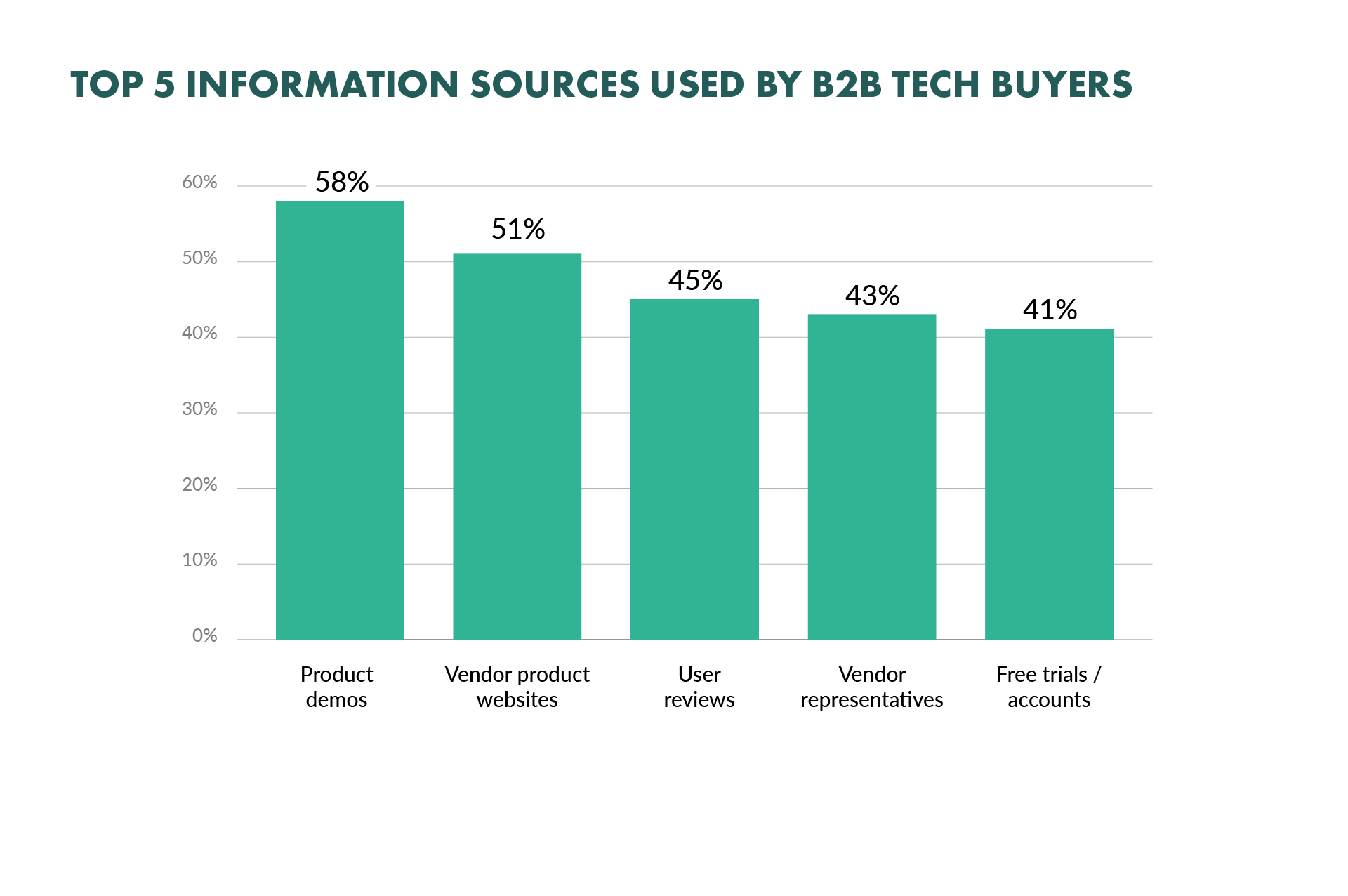
Modern buyers are highly skeptical about sales and marketing messages they encounter.
According to a Forrester report, 59% of buyers prefer to do research online instead of interacting with a sales rep because the rep pushes a sales agenda rather than helps solve a problem.
At the same time, salespeople continue to focus on selling, rather than helping prospects along their path to purchase.
It’s no wonder that 68% of buyers prefer to interact with salespeople who listen to their needs and provide them with relevant information. And that 57% admitted they’d prefer to purchase from a salesperson who “doesn’t try to apply pressure or hassle them when following up.”
It’s also no surprise that sales teams who incorporate social selling into their strategies tend to perform better than those that don’t.
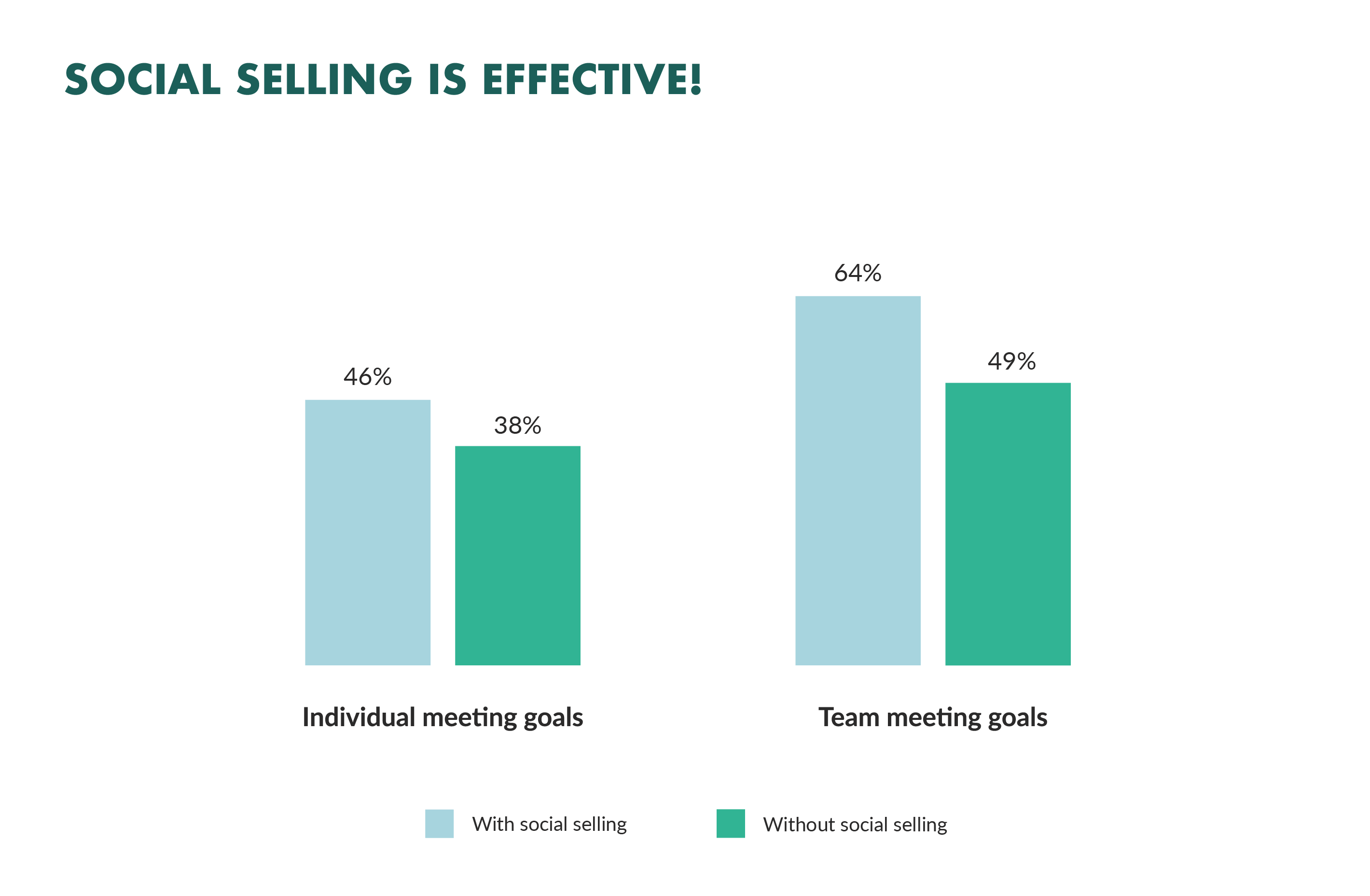
Here’s another thing that’s changed in recent years:
Today’s buyers now take longer to make a purchase decision.
Recent trends reveal that the SaaS B2B sales cycles have lengthened, now averaging an additional 3.8 weeks to close a new customer. This adjustment reflects the evolving complexity and deliberation in B2B purchasing decisions.
With the lengthening of sales cycles, businesses are facing increased Customer Acquisition Costs (CAC) and extended CAC payback periods. These challenges necessitate a reevaluation of sales strategies to enhance efficiency and effectiveness
Another reason for that is more people involved in the process. According to Gartner, in a typical firm (100-500 employees), an average of 7 people are involved in most buying decisions.
Another reason is, the wealth of information available that buyers can use to base their decisions on.
This, combined with the shift in the selling process, forces organizations to try and connect with customers and start nurturing them as early in the process as possible.
Modern buyers pay a lot of attention to peer recommendations.
Native to the online world of information, modern (millennial) buyers are 2x more likely to discover products by searching the web or via social media.
The overwhelming majority (9 out of 10) B2B buyers admit that online content has a moderate to major effect on their purchasing decisions.
Next, they don’t trust the “traditional” analytical reports or rankings as much as older generations (Generation X or Baby Boomers). Less than 20% of millennials use analyst rankings.
But what makes them really tick is reviews! According to research, 8 out of 10 millennial buyers won’t make a purchase without reading a review first. In other words, peer-powered content is the most trusted by modern buyers.
Finally, they are also aware of risks associated with purchases.
Modern buyers want to feel confident that they’ve made the right decision, and try to do as much as possible to mitigate post-purchase dissatisfaction during the sales process.
“Prospects often second-guess themselves over making the right choices or are afraid to commit and potentially missing out on a better vendor. B2B buyers are also increasingly seeking out ways to identify and reduce risk factors, including damage to professional credibility, reduction in job security, inability of the software to technically perform as promised, and loss of monetary investments.”
All this results in a wide range of challenges for the modern B2B sales teams to overcome:
- The increase of available information allows prospects to go through the sales process by themselves, without any need for interaction with the vendor. This resulted in a diminished influence of salespeople over the buyer's choice.
- Sales and marketing teams become more misaligned, often confused as to their roles in the new sales process.
- Buyers become skeptical about marketing and sales messages, and the trustworthiness of sales in general.
- And social media and peers, instead of salespeople, hold a strong influence over buying decisions.
The table below shows the key differences in approach between traditional B2B sales and modern-day B2B sales:
| Traditional B2B sales | Modern-day B2B sales | |
| Tools | Analog | Digital |
| Outreach | Generic | Personalized |
| Prospecting | Cold calling | Social networks |
| Research | Limited to internal records | Gather online intelligence |
| Engage | In-person | Ominchannel |
| Sales pitch | Scripted | Concersational |
How to overcome modern sales challenges
Luckily, there are ways to overcome these sales challenges, and here are 3 of the most effective ways to help you generate better quality leads.
Embrace sales enablement to help prospects make better buying decisions
Just because today’s buyers prefer to conduct research online themselves, it doesn’t mean that they can’t interact with you during the process.
Quite the opposite, in fact.
You see, B2B buyers rely on the content to guide them through the buying process, and gain the knowledge necessary to make an informed decision.
And although they can easily find the information, it isn’t always the right kind of information.
And here lies your opportunity.
Create a content library including all your assets that answer the most common questions your target audience asks at different stages of their buying journey.
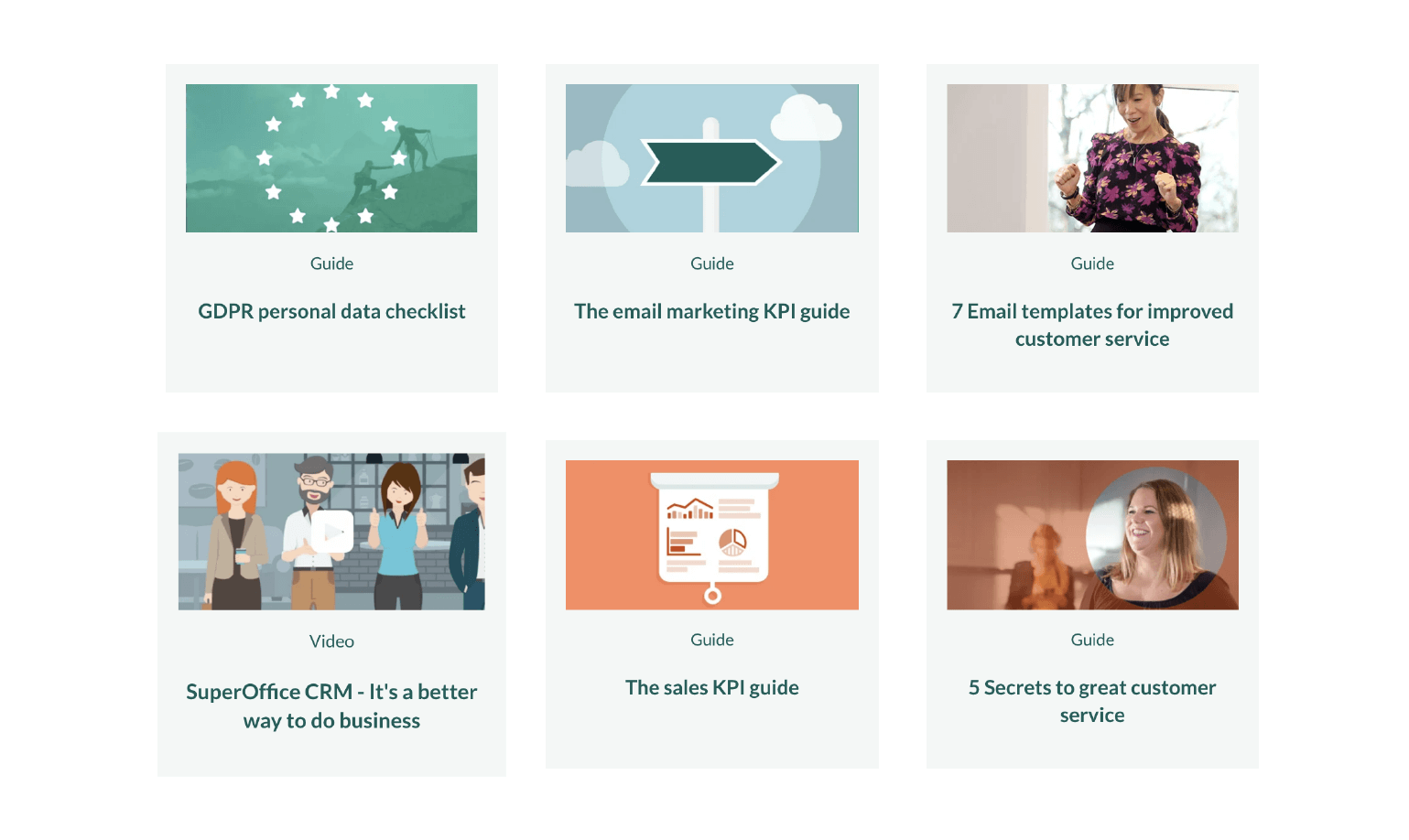
Once you have created a content library, you can then ask your salespeople to proactively share them with their prospects.
But, what kind of content should you share?
Research from Live Hive found that decision makers are much more responsive towards sales reps when they include case studies, industry articles, sales collateral and white papers in their outbound strategy.
And if you still doubt how effective this is, consider the following:
- 95% of buyers select a vendor who provided them with ample content to help navigate through each stage of the buying process
- 68% of customers feel more positive about a brand after consuming content from it
- 82% of buyers viewed at least 5 pieces of content from the winning vendor
- And companies that develop sales enablement strategies typically win 13.7% higher contract value
Once our sales teams started using content from our library and sharing it with their network on LinkedIn, they saw an increase in reach (impressions) grow from 1,600 views per month to now more than 45,000 views!
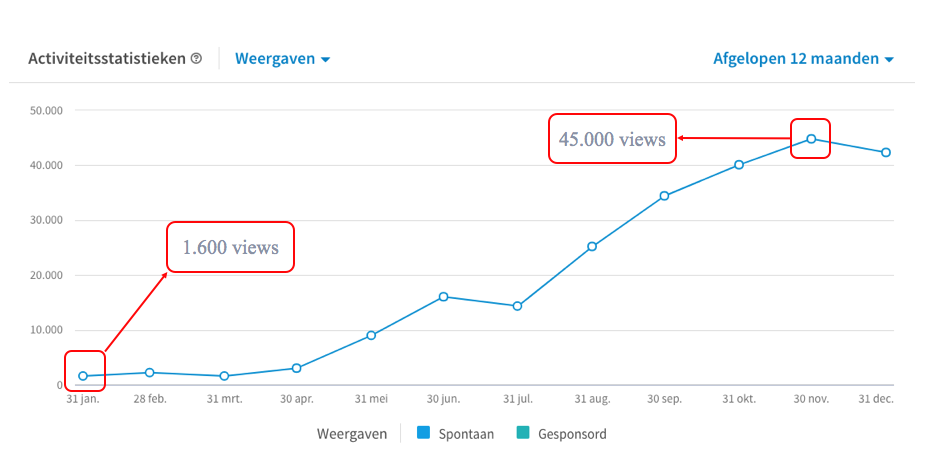
Prospects are seeing more of our content than ever before and as we are sharing the right kind of content, we are able to generate better quality leads.
Store all of your sales and marketing collateral inside SuperOffice CRM. Tag content based on segments you’ve created, so that sales reps can share content with relevant buyers that match your ICP.
Get more use cases on how to use SuperOffice CRM by booking a demo.
Make salespeople the spokesmen (and women) for your brand
Sending your prospects relevant content will help you close more deals.
But, that’s not the only way to use content to overcome modern B2B sales challenges.
Another way is to position your salespeople as experts in the field.
Here’s why:
We know that modern B2B buyers are becoming increasingly skeptical about sales and marketing messages.
And that many B2B buyers want to interact with salespeople who listen to their needs and provide them with relevant information.
Now, imagine how buyers would feel about a sales rep (and in turn, the brand they work for) that has shared insights and information relevant to their pain points?
Yes, you guessed it - as expert's worth paying attention to!
Here’s how you can achieve this.
Have salespeople create and share content that’s helpful, informative and relevant to the buyer’s pain points, and allow them to publish articles on your company’s blog (and repost on their LinkedIn profile).
Stein Ove Sektnan, Managing Director at SuperOffice UAB has been sharing original content on LinkedIn since 2014. The content he creates covers CRM, customer service, data management and strategy - all related to his experience.
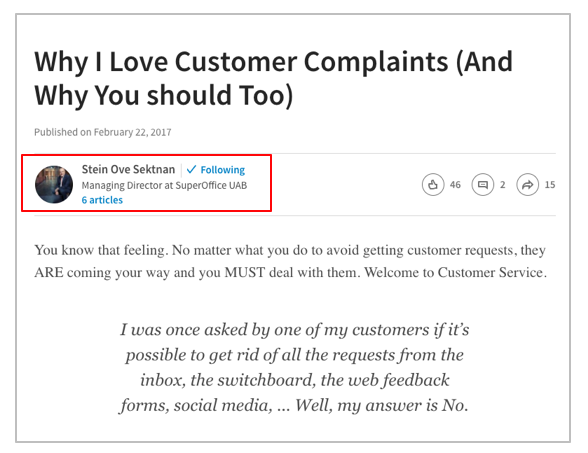
In this piece on customer complaints, the post received 46 likes and 15 shares.
Based on average number of LinkedIn connections (approx. 900), this means his content was seen by 50,000 people!

When your sales team create content, make sure that the content they publish provides a unique perspective on prospect’s challenges, and then provide them with actionable insights they could use to progress through the customer journey.
Align sales and marketing teams to work towards the same goal
According to various studies, sales and marketing misalignment can cost companies 10% or more of revenue per year.
Then again, it’s not that surprising, is it?
Think about the typical problems arising from misalignment:
- Lack of common definition of a qualified lead, resulting in marketing delivering contacts salespeople simply can’t close.
- No unified content library, meaning that sales teams can’t find assets to forward to prospects. And we’ve already discussed how crucial that is to the sales process.
- Irrelevant KPIs that fail to assist in improving each team’s performance
At the same time, 56% of companies with both teams aligned met their revenue goals, and 19% exceeded them.
Other benefits of aligning sales and marketing include increased brand awareness, an increase in average deal size and annual company revenue.
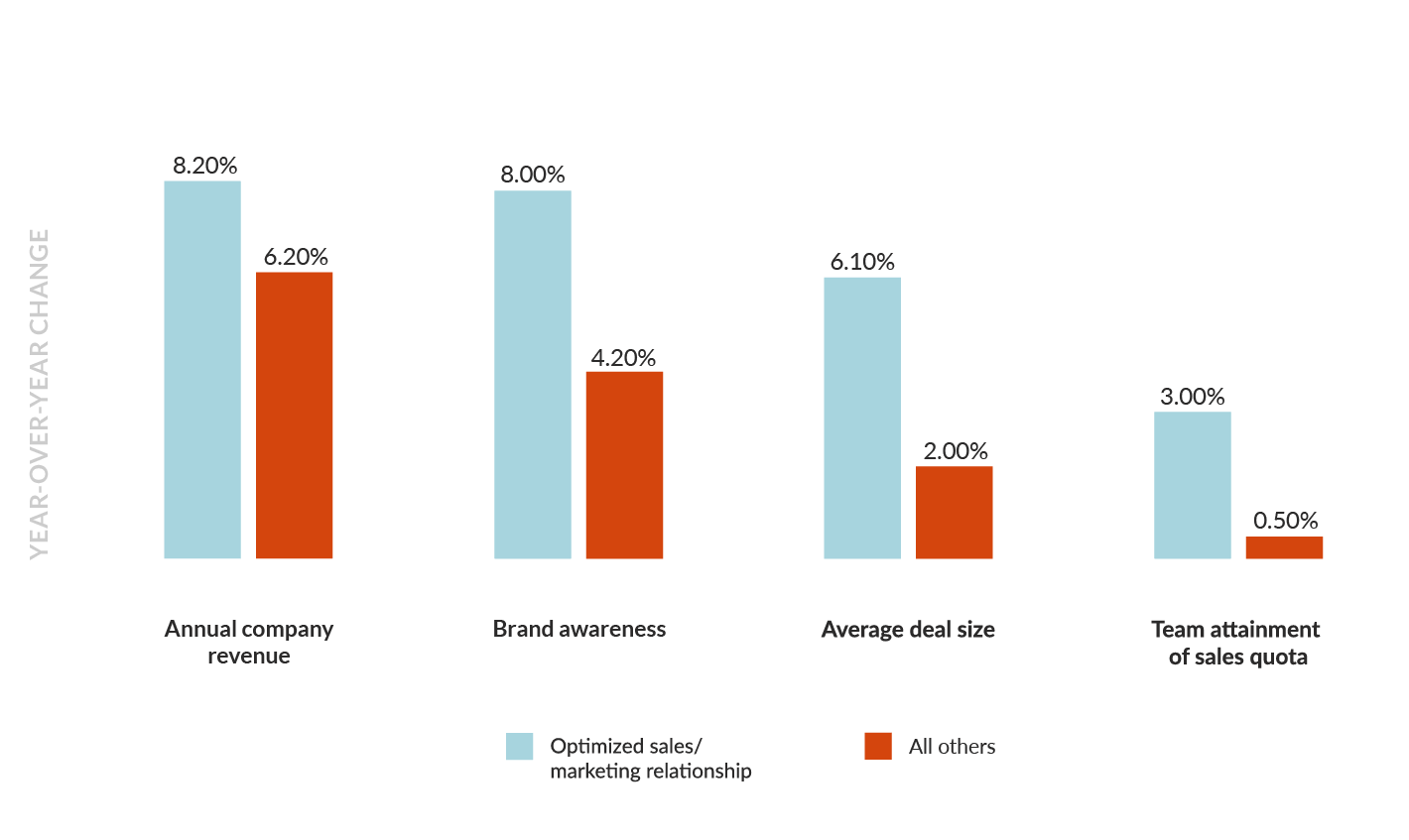
And do you know what the secret is to be achieving this?
Use content to align both teams.
Research by Corporate Visions found that less than a third of businesses include sales teams in messaging and content creation.
So, here’s how you can get started:
- Create a content library, and get marketing teams to regularly contribute assets salespeople can then use to generate better quality leads.
- Let marketers educate sales teams on when and how to use the content
- Allow salespeople to guide new content development by contributing their ideas.
- Host regular meetings between two teams to coordinate their efforts.
We use this exact approach at SuperOffice when it comes to using content to align sales and marketing teams.
Here's how:
- Marketing create content around a specific challenge or pain-point
- Marketing share the content with our salespeople
- Marketing and sales share the content through email and social media
- Salespeople take the content and create a PowerPoint presentation to use in a webinar
- Salespeople invite all leads that downloaded the content to a live webinar
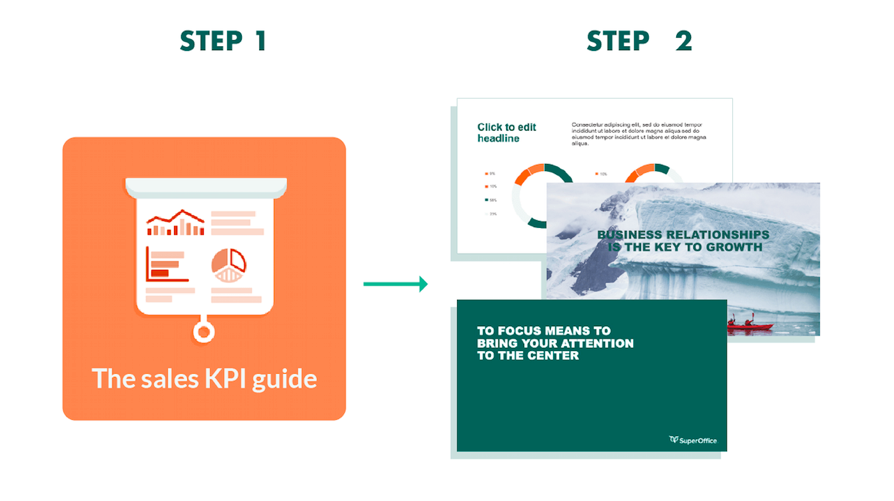
The reason this approach works is that salespeople not only take the content that marketing have created and use it to host a webinar, but they use it to move prospects further down the buyers funnel by addressing specific needs they have that our product can solve.
By now, the prospect has read the content, attended a live webinar and seen how our product solves their challenges - resulting in a better quality and more qualified lead for our sales team.
Wouter Schram, our resident sales and marketing expert in the Netherlands, has spent the last five years aligning sales and marketing teams. Here’s what he had to say on the topic.
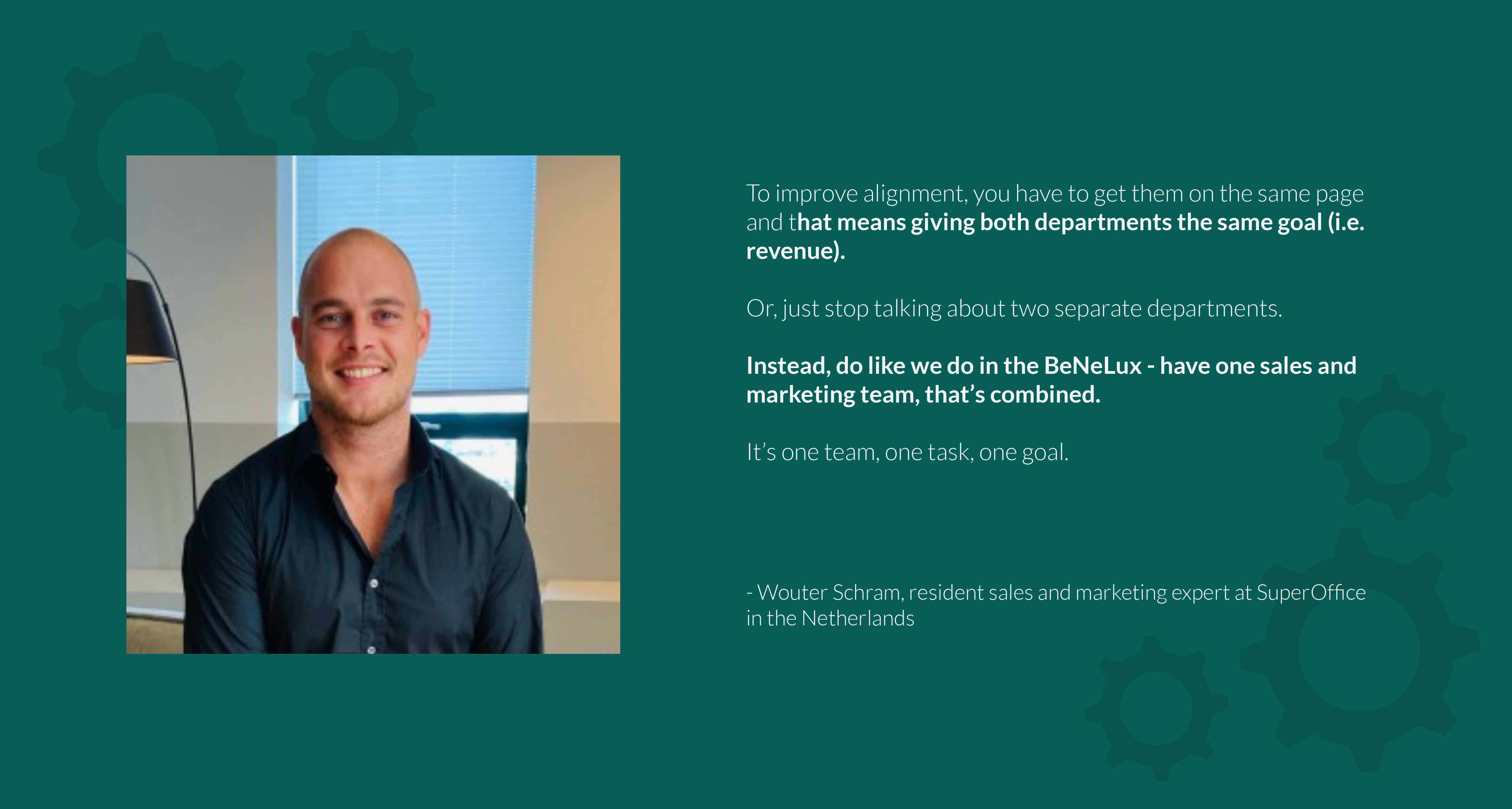
Conclusion
B2B sales has changed.
It’s no longer as simple as waiting for prospects to come to you.
Instead, you need to be proactive and find the channels where potential customers are and share relevant content with them that addresses their needs. You also need to work closely with your marketing department and use the content they create as a sales tool to move prospects further down the sales funnel.
By doing this, you will start building stronger business relationships with your buyers and, more importantly, you will gain their trust - and that's the the key to succeeding in modern B2B sales.
Sales managers at companies like Sharp, Bridge Technologies and SBC use SuperOffice to create a better sales experience.
Book a 30-minute meeting today with one of our sales experts. We’ll discuss your sales goals and how we can help you reach them.
Customers also ask:
What are the four types of B2B selling?
There are four basic categories when it comes to B2B selling - producers, resellers, governments and institutions.
What makes a good B2B salesperson?
The best salespeople have one thing in common - they are good listeners. A good listener will use the information provided from a buyer to sell more effectively.
What is the golden rule of B2B sales?
The golden rule in B2B selling is to focus on the customer and their needs, as opposed to focusing on short-term sales that result in commissions and bonuses.
How can B2B sales teams effectively integrate digital tools into their sales process to better engage with the modern buyer?
- To effectively integrate digital tools into the B2B sales process, sales teams can start by adopting Customer Relationship Management (CRM) systems like SuperOffice CRM. These systems help in tracking customer interactions and managing leads efficiently.
- Utilizing social media platforms for 'social selling' is another strategy. Sales representatives can leverage LinkedIn and other professional networks to connect with potential buyers, share insightful content, and build relationships.
- Implementing content management systems to organize and share relevant content with buyers at different stages of their journey is crucial. This includes whitepapers, case studies, and educational blog posts that provide value and position the company as a thought leader.
- Incorporating analytics and data-driven tools to understand buyer behavior and preferences better. This helps in personalizing interactions and tailoring the sales approach based on data insights.
What are some specific examples of successful B2B sales strategies in various industries, such as technology or manufacturing?
Specific examples of successful B2B sales strategies include:
- In the technology industry, offering free trials or demos has proven effective. It allows potential customers to experience the product firsthand, leading to more informed purchase decisions.
- For manufacturing, building long-term relationships and focusing on account-based marketing (ABM) can be more effective. This involves targeting specific high-value accounts with personalized marketing and sales efforts.
- In the service sector, leveraging customer success stories and testimonials can be a powerful tool to showcase the value and reliability of the services offered.
How can B2B companies balance the need for personalized customer interactions with the efficiency of automated marketing and sales processes?
Sales reps can balance personalization with efficiency in marketing and sales by:
-
- Automation tools can be used to handle repetitive tasks such as sending initial outreach emails or scheduling social media posts, allowing sales teams to focus on more personalized interactions.
- Segmenting the customer base and creating personalized content for each segment can make personalization more manageable. This approach provides a semi-custom customer experience without the need for entirely bespoke content for each prospect.
- Using AI can help in predicting customer needs and behavior, thus enabling sales teams to offer personalized recommendations and solutions efficiently.
Resources you will love:
- B2B vs B2C Sales: 10 Differences and 9 Similarities
- Future of Sales 2025: Deliver the Digital Options B2B Buyers Demand
- Sales Process: A Roadmap To Better Sales Performance
- Social Selling: A Sales Reps Guide To Social Media Success
- GDPR For Sales: How To Acquire New Customers Without Breaking The Law!



